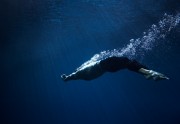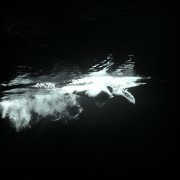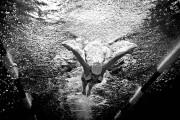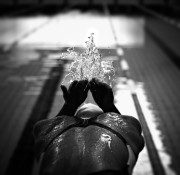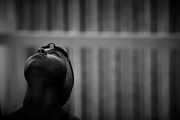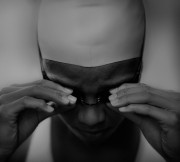Still Images In Great Advertising, is a column where Suzanne Seasediscovers great advertising images and then speaks with the photographers about it.
I am trying to do a series for this column featuring some of the winner’s from this year’s Communication Arts Photography Annual, so I reached out to Simon Harsent. One of the things I love about Simon’s work is that his assignment work is an inspiration of the work in his galleries that are a combination of assignment and personal work.

Suzanne: How did this beautiful project come about when you don’t have any underwater images on your current website?
Simon: I had just finished shooting a personal series called “Into the Abyss” which was originally meant for a group show I was involved with late last year.
I had an idea to shoot women completely consumed by water whilst I was shooting another ongoing project of the ocean, the idea with “Into the Abyss” was to have her falling gracfully though water and seemingly into an Abyss, the final exhibition. I collaborated with my father who is a Poet who wrote a piece for it and I also had a video installation playing on multiple screens.
Around the same time I was shooting “Into the Abyss”, I got a call from Noah Regan who was the Creative Director at the Ad Agency The Monkeys. He was working on The Ship Song Project and asked me if I was interested in doing the poster for it.
The Ship Son Project is a re-recording of a Nick Cave song of the same name by various famous Australian and International musicians, it’s a celebration at what goes on behind the scenes at one of the worlds most recognizable buildings.
The Opera House structure was said to have been inspired by Sail’s, so that was the starting point for the poster idea, the original idea was just to shoot the Sydney Opera House. In a split level shot and the words The Ship Song Project were to be made up of discarded things floating under the water such as barrels, ropes and bits of timber. When Noah was showing me the idea I talked to him about the “Into the Abyss” exhibition I was working on and suggested we do something similar to the girl under the water. I liked the idea of having the women in the water to represent a Siren and the bubbles that trail her would act almost as the hull of a ship emphasizing and playing on the sails of the Opera House structure. Luckily Noah loved the suggestion.
I’ve known Noah for a long time and have always done great work, most recently we worked on a Charity project for Guide Dogs for the Blind. We shot four print ads and directed four TV spots. With clients like Noah, I’m lucky enough to be asked to be involved at quite an early stage on a lot of projects. I like the collaborative process and trust that happens when working this way.
Suzanne: I love that the Opera House is in the background. What were the challenges in getting this shot?
Simon: Shooting the Opera House was quite a tricky shot, the easy way to do it would have been to shoot the water level and the opera house as two shots but I wanted it to include the water level in the shot of the Opera house so I could use the whole portion of that shot. I try to shoot as few elements as possible when doing multiple comp shots I feel the little eccentricities that happen when you do stuff like this add to the realism. The area that the Opera House is seen from is called Circular Quay and it is the where all the harbor ferries pull into port so the water traffic is very busy plus there are quit a few bull sharks in the harbor so getting in the water wasn’t really an option, I ended up shooting it off the back of a water taxi, I had to lie down on the deck between the back of the boat and where the engines are attached. I had my Canon 1Dlll in an Aqua Tech underwater housing and I just held the camera half in the water while I was shooting, the most challenging thing was the chop of the water, the swell combined with the passing boats made it quite a challenge to get the perfect shot.
Suzanne: Was doing the work for World Wildlife Federation the inspiration for your fine art show: Melt? The campaign and the show were the same year.
Simon: No it was the other way round. I had already completed Melt, when some friends of mine were working on the WWF Campaign. They had this idea for the ghost effect when they saw my shots from Melt and asked if I would be interested in working on the campaign, obviously I jumped at the chance. For the Iceberg ad we used an image that I had taken when I was shooting Melt and the other three images were shot specifically for the Campaign.
It happens quite often that people will see something in my personal work they would like to re-create for an ad. I think that is why it’s so important to show personal work on your website.
To be honest ultimately for me it’s about my personal work, if I didn’t do commercial work I’d still be a photographer (just a very broke one). I love photography it’s much more than a job to me, it’s who I am and the commercial work finances the personal work. But the personal work has and will always be the most important aspect of what I do.
To be able to do a project like Melt was amazing but I only could have done it with the freedom to produce the images I did because it was self-financed. That’s one of the reasons I do commercial work but also I like the discipline and the creative collaboration that comes with producing commercial work. I like the problem solving aspect and working as a team it’s very different to how I do my personal work, which is quite often by myself or with very little crew.
Suzanne: You have continued to do work for charitable organizations like World Wildlife Federation and it continues to win high honor awards. How has that client been in getting advertising campaigns?
Simon: As far as getting other commissions from the work I do for charity I really don’t think it differs from other work that is on my website or in my portfolio.
The recognition at award shows is nice, I’ve never been really sure if it directly effects future commissions but it does help to keep your name out there and acts as a form of endorsement to a certain extent.
I think advertising photographers are far more likely to get more work from shooting an ad that wins awards for the idea rather than the photograph alone.
Years ago I shot an ad that won the Grand Prix at Cannes my phone didn’t stop ringing for ages, I’ve never had the same effect after winning a photography award, I think mostly Art Directors are interested in the idea and that you as a photographer understand ideas and can make them better.
I think it’s important to do charity work if you can, apart from the feel good factor quite often it can be less restrictive so the creative product is often better than everyday advertising. There is a freedom that you get with charity work that you don’t normally get with other advertising work. Having said that I don’t really look at in any different way to regular advertising, the main aim for me is always to do something I would be proud to put in my portfolio which hopefully leads to new work.
Suzanne: The work in your assignment gallery has a diverse selection of ads you have done. While the other galleries are definite examples of the inspiration to the ad work but some ads are so different than that work. Are you at a level in your career that you can use your assignment work for a selection of great ads and the galleries are images that are what you want to show?
Simon: To be honest I’ve always done that, maybe to my detriment at times, I could make both my portfolio and website more centered but I try to put in my portfolio and website what I love to shoot and ads that I’m proud of regardless of whether they are a still life a landscape or portrait. Part of what I like doing with advertising is creating a look that is specific to the job in question and as the industry goes in and out of phases and trends, you as a photographer find yourself moving with them.
I think if you are showing ads then you should show the better ones ultimately Art Directors and to a certain extent Art Buyers are looking at the quality of ads you are working on as well as the quality of photography. I know some people will show an ad just because it’s a big brand but I’m not like that. I think people want to be inspired when they look at your work which is why my website is more centered on personal work and projects.
Having said that my website is due a massive update. I’ve been so busy I haven’t had a chance to update it for over a year, I also find it very time consuming. I put a lot (probably too much) of thought into it and how people will look at it and how I want them to experience my work.
The reality is that I enjoy shooting a variety of things. I’m not the type of photographer who just shoots one thing, I started my career in London as a still life photographer because that’s what I fell into and over the years I have now progressed into what I do now. But I’ve always loved to shoot a variety of things, it’s one of the reasons I like doing advertising work. You do get the opportunity to work on different types of projects and tackle them in different ways.
My intention has always been to approach advertising work in the most artistic way I can, and try when I can to approach it in the same way I would if it was a personal project but the most important thing in advertising is the idea. What I need to do is find the best way to communicate that idea and if possible enhance the idea with the photograph.
I do find that in some cases, like that of the Ship Song and the WWF, that Art Directors can get inspiration from my personal stuff. I’m lucky in the fact lot of my clients are people I have worked with for years so they know me quite well and trust me to bring something to their idea. Being in the business as long as I have I you understand what the creatives have had to go through to get it this far. When you understand the amount of presentations, rounds of revisions and the general struggle they have gone through to get the campaign this far you realize that they are handing over and trusting you with months of hard work. That can be quite a responsibility and needs to be treated that way.
Suzanne: Do you think moving to Australia was the best thing you did for your career? Because when you moved to New York you had a great body of work and you have been very successful since.
Simon: To a certain extent yes I do. I think it was a great springboard and I still spend a bit of time there every year. I’m part of a collective with four other photographers in Sydney. We do joint exhibitions and have just released an App on iTunes. I really like the interaction that brings with other photographers. Photography can be quite a lonely pursuit at times so it’s good to have people to bounce ideas off of.
I also love the carefree attitude of the Aussies and quite often the work that comes out of there is good creative work such as the WWF and the Ship Song. But moving to NY in 97 for me was the best thing I ever did for my career. It was also the hardest and still throws up challenges. It was like starting over, it really didn’t matter what I had done before I got to NY, it is a tough town and I had a bit of a shock when I got here for lots of different reasons. First, because I realized I was a small fish in a very large pond and second I didn’t realize how specialized photographers were here. There aren’t just Still Lifers there are Still Lifers who specialize in liquid, Still Lifers who specialize in pours, watches etc. etc. The same with landscapes, cars, portraits they were all broken down to such a micro levels of specialization. I found it quite amazing coming from a place where one day you would be shooting a car and the next day a nude. So at the start a lot of my portfolio would just confuse people and it took a while for people to understand what I was about. It took a lot of hard work to adjust at the time but also it taught me the most important lesson I’ve ever learnt, that I could never take anything in my career for granted. I realized then that it was going to take a lot of hard work to have a successful career in the US, but like a friend on mine says “if it was easy everybody would be doing it”
A lot of that has changed now the market has change dramatically. I think ad agencies are embracing diversity in peoples work these days. The thing about New York was the amount of talented photographers and the level of photographers you compete against are the best of the best, which is true now more than ever. When I first moved to NY mostly you would be competing against photographers based in either NY or North America. But these days as a NY based photographer you are not just up against local photographers you are up against everybody from around the world who has an agent here and some that don’t. That and the fact it’s a lot easier to be a photographer these days means the ad agencies have a much bigger pond to fish from so you have to be incredibly focused on your career. I guess it’s a good thing I’m enjoying it more than ever right now. Mostly thanks to Canon, digital changed everything for me it reinvented my enthusiasm in photography again. I used to shoot a lot of large format black and white but when I got into digital it was like being a kid again and discovering something for the first time. I do miss my 8×10 and 4×5 cameras and I recently did a shoot with the 20×24 Polaroid camera which was amazing but digital really helped me discover a whole new side of my work.
Note: Content for Still Images In Great Advertising is found. Submissions are not accepted.
Simon Harsent was Born in Aylesbury, a small market town in England, where his passion for photography grabbed him from an early age. He enrolled to study the subject at Watford College and, after graduating, he went on to assist some of London’s top photographers. In order to pursue his passion further, he left London and with it another great love – Chelsea Football Club – when he moved to Australia in 1988. From Australia then ten years later on to New York along the way he has received numerous national and international awards and been featured in a host of magazines and books (Cannes Lions, One Show, Clio, D&AD, London International, Australia’s first Cannes Grand Prix, Archive, Campaign Brief, Creativity, Communication Arts, Capture, Graphis, Photo, the D&AD Art Direction book and Photo District News).
Currently dividing his time between New York and Sydney, Harsent continues to work on award-winning campaigns for some of the world’s top advertising agencies and designers while working on gallery projects such as his 2009 collection, Melt.
APE contributor Suzanne Sease currently works as a consultant for photographers and illustrators around the world. She has been involved in the photography and illustration industry since the mid 80s, after founding the art buying department at The Martin Agency then working for Kaplan-Thaler, Capital One, Best Buy and numerous smaller agencies and companies.



























































